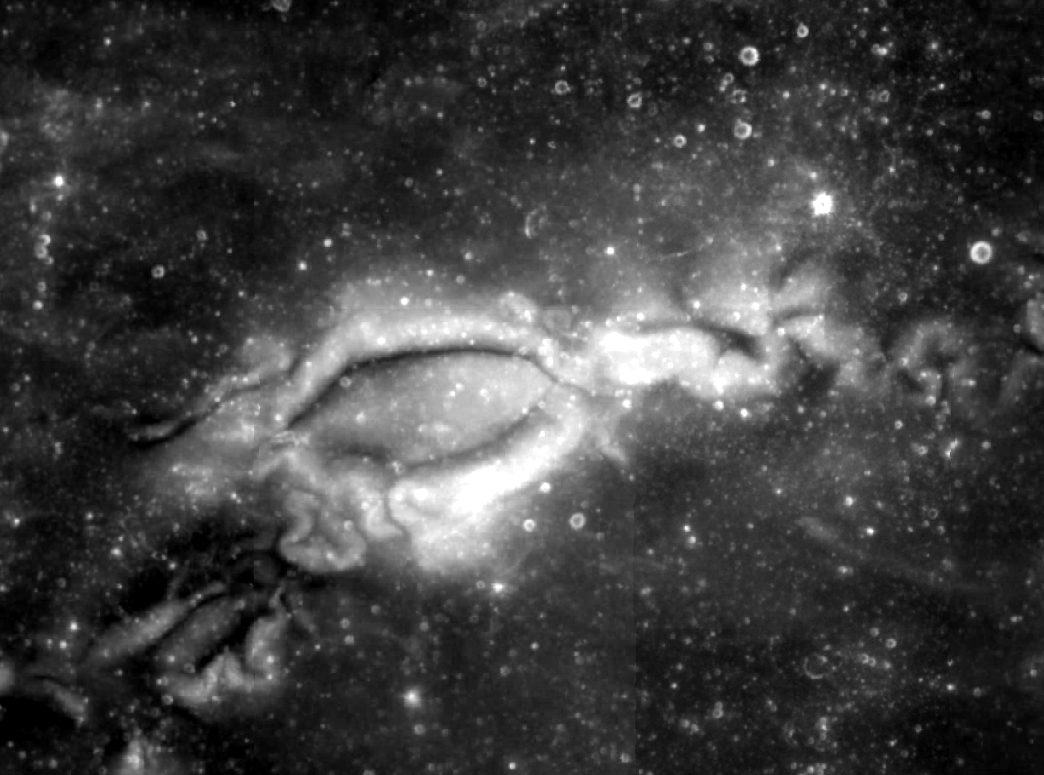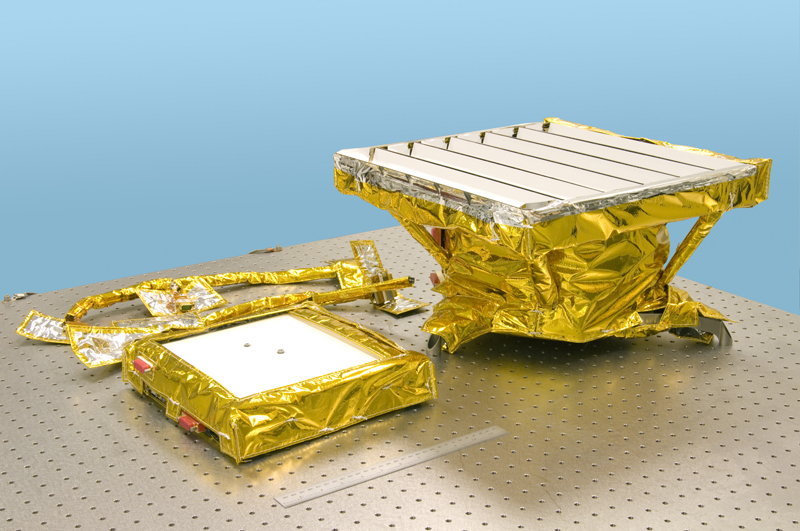|
Lunar Swirls
Lunar swirls are enigmatic features found across the Moon's surface, which are characterized by having a high albedo, appearing optically immature (i.e. having the optical characteristics of a relatively young regolith), and (often) having a sinuous shape. Their curvilinear shape is often accentuated by low albedo regions that wind between the bright swirls. They appear to overlay the lunar surface, superposed on craters and ejecta deposits, but impart no observable topography. Swirls have been identified on the lunar mare, lunar maria and on Geology of the Moon, highlands - they are not associated with a specific lithologic composition. Swirls on the maria are characterized by strong albedo contrasts and complex, sinuous morphology, whereas those on highland terrain appear less prominent and exhibit simpler shapes, such as single loops or diffuse bright spots. Association with magnetic anomalies The lunar swirls are coincident with regions of the magnetic field of the Moon with ... [...More Info...] [...Related Items...] OR: [Wikipedia] [Google] [Baidu] |
Reiner Gamma
Reiner Gamma (γ) is a geographical feature of the Moon known as a lunar swirl. It is one of the most visible lunar swirls from Earth, visible from most telescopes. It was originally thought to be a lunar highland, but scientists eventually realized that it cast no shadow on the moon. Origin The origin of Reiner Gammalike other lunar swirlsis not completely understood. It is associated with a localized magnetic field, but not with any particular irregularities in the surface. Similar features have been discovered in Mare Ingenii and Mare Marginis by orbiting spacecraft. The feature on Mare Ingenii is located at the lunar opposite point from the center of Mare Imbrium. Likewise the feature on Mare Marginis is opposite the midpoint of Mare Orientale. Thus one hypothesis is that the feature resulted from seismic energies generated by the impacts that created these maria. However, no such lunar mare formation is on the opposite side of the Moon from Reiner Gamma. Location and Feature ... [...More Info...] [...Related Items...] OR: [Wikipedia] [Google] [Baidu] |
Solar Wind
The solar wind is a stream of charged particles released from the upper atmosphere of the Sun, called the corona. This plasma mostly consists of electrons, protons and alpha particles with kinetic energy between . The composition of the solar wind plasma also includes a mixture of materials found in the solar plasma: trace amounts of heavy ions and atomic nuclei such as C, N, O, Ne, Mg, Si, S, and Fe. There are also rarer traces of some other nuclei and isotopes such as P, Ti, Cr, 54Fe and 56Fe, and 58Ni, 60Ni, and 62Ni. Superposed with the solar-wind plasma is the interplanetary magnetic field. The solar wind varies in density, temperature and speed over time and over solar latitude and longitude. Its particles can escape the Sun's gravity because of their high energy resulting from the high temperature of the corona, which in turn is a result of the coronal magnetic field. The boundary separating the corona from the solar wind is called the Alfvén surface. At a distance of ... [...More Info...] [...Related Items...] OR: [Wikipedia] [Google] [Baidu] |
Geological Features On The Moon
Geology () is a branch of natural science concerned with Earth and other astronomical objects, the features or rocks of which it is composed, and the processes by which they change over time. Modern geology significantly overlaps all other Earth sciences, including hydrology, and so is treated as one major aspect of integrated Earth system science and planetary science. Geology describes the structure of the Earth on and beneath its surface, and the processes that have shaped that structure. It also provides tools to determine the relative and absolute ages of rocks found in a given location, and also to describe the histories of those rocks. By combining these tools, geologists are able to chronicle the geological history of the Earth as a whole, and also to demonstrate the age of the Earth. Geology provides the primary evidence for plate tectonics, the evolutionary history of life, and the Earth's past climates. Geologists broadly study the properties and processes of Eart ... [...More Info...] [...Related Items...] OR: [Wikipedia] [Google] [Baidu] |
Transient Lunar Phenomenon
A transient lunar phenomenon (TLP) or lunar transient phenomenon (LTP) is a short-lived light, color or change in appearance on the surface of the Moon. The term was created by Patrick Moore in his co-authorship of NASA Technical Report R-277 ''Chronological Catalog of Reported Lunar Events'', published in 1968. Claims of short-lived lunar phenomena go back at least 1,000 years, with some having been observed independently by multiple witnesses or reputable scientists. Nevertheless, the majority of transient lunar phenomenon reports are irreproducible and do not possess adequate control experiments that could be used to distinguish among alternative hypotheses to explain their origins. Most lunar scientists will acknowledge transient events such as outgassing and impact cratering do occur over geologic time. The controversy lies in the frequency of such events. Description of events Reports of transient lunar phenomena range from foggy patches to permanent changes of the luna ... [...More Info...] [...Related Items...] OR: [Wikipedia] [Google] [Baidu] |
Applied Physics Laboratory
The Johns Hopkins University Applied Physics Laboratory (Applied Physics Laboratory, or APL) is a not-for-profit University Affiliated Research Center, university-affiliated research center (UARC) in Howard County, Maryland. It is affiliated with Johns Hopkins University and employs 8,000 people (2022). The lab serves as a technical resource for the United States Department of Defense, Department of Defense, NASA, and other government agencies. APL has developed numerous systems and technologies in the areas of air and missile defense, surface and undersea naval warfare, computer security, and space science and spacecraft construction. While APL provides research and engineering services to the government, it is not a traditional defense contractor, as it is a UARC and a division of Johns Hopkins University. APL is a scientific and engineering research and development division, rather than an academic division, of Johns Hopkins. Hopkins' Whiting School of Engineering offers par ... [...More Info...] [...Related Items...] OR: [Wikipedia] [Google] [Baidu] |
Space Tether
Space tethers are long cables which can be used for propulsion, momentum exchange, stabilization and attitude control, or maintaining the relative positions of the components of a large dispersed satellite/spacecraft sensor system. Depending on the mission objectives and altitude, spaceflight using this form of spacecraft propulsion is theorized to be significantly less expensive than spaceflight using rocket engines. Main techniques Tether satellites might be used for various purposes, including research into tether propulsion, tidal stabilization and orbital plasma dynamics. Five main techniques for employing space tethers are in development: ;Electrodynamic tethers Electrodynamic tethers are primarily used for propulsion. These are conducting tethers that carry a current that can generate either thrust or drag from a planetary magnetic field, in much the same way as an electric motor does. ;Momentum exchange tethers These can be either rotating tethers, or non-rotating ... [...More Info...] [...Related Items...] OR: [Wikipedia] [Google] [Baidu] |
BOLAS (spacecraft)
Bi-sat Observations of the Lunar Atmosphere above Swirls (BOLAS) is a spacecraft mission concept that would orbit the Moon at very low altitude in order to study the lunar surface. The concept, currently under study by NASA, involves two small identical CubeSat satellites connected vertically above the lunar surface by a 25 km long tether. The mission goal would be to understand the hydrogen cycle on the Moon, dust weathering, and the formation of lunar swirls. Overview BOLAS is a mission concept under study at NASA, with the goal of understanding the cycle of hydrogen on the Moon and to determine the formation mechanism of the lunar swirls. The mission would involve two small CubeSat satellites connected with a long space tether. [...More Info...] [...Related Items...] OR: [Wikipedia] [Google] [Baidu] |
Chandrayaan-1
Chandrayaan-1 (, ) was the first Indian lunar probe under the Chandrayaan program. It was launched by the Indian Space Research Organisation in October 2008, and operated until August 2009. The mission included a lunar orbiter and an impactor. India launched the spacecraft using a PSLV-XL rocket on 22 October 2008 at 00:52 UTC from Satish Dhawan Space Centre, at Sriharikota, Andhra Pradesh. The mission was a major boost to India's space program, as India researched and developed indigenous technology to explore the Moon. The vehicle was inserted into lunar orbit on 8 November 2008. On 14 November 2008, the Moon Impact Probe separated from the Chandrayaan orbiter at 14:36 UTC and struck the south pole in a controlled manner, making India the fourth country to place its flag insignia on the Moon. The probe hit near the crater Shackleton at 15:01 UTC The location of impact was named Jawahar Point. The estimated cost for the project was . It was intended to survey th ... [...More Info...] [...Related Items...] OR: [Wikipedia] [Google] [Baidu] |
Moon Mineralogy Mapper
The Moon Mineralogy Mapper (M3) is one of two instruments that NASA contributed to India's first mission to the Moon, Chandrayaan-1, launched October 22, 2008. It is an imaging spectrometer, and the team is led by Principal investigator Carle Pieters of Brown University, and managed by NASA's Jet Propulsion Laboratory. Description M3 is an imaging spectrometer that provided the first high-resolution spatial and spectral map of the entire lunar surface, revealing the minerals of which it is made. This information will both provide clues to the early development of the Solar System and guide future astronauts to stores of precious resources. This instrument is a Discovery Program "Mission of Opportunity" (a NASA-designed instrument on board another space agency's spacecraft). Chandrayaan-1 operated for 312 days as opposed to the intended two years but the mission achieved many of its planned objectives. M3 was used to map over 95% of the lunar surface in its low-resolution Glo ... [...More Info...] [...Related Items...] OR: [Wikipedia] [Google] [Baidu] |
Lunar Reconnaissance Orbiter
The Lunar Reconnaissance Orbiter (LRO) is a NASA robotic spacecraft currently orbiting the Moon in an eccentric polar mapping orbit. Data collected by LRO have been described as essential for planning NASA's future human and robotic missions to the Moon. Its detailed mapping program is identifying safe landing sites, locating potential resources on the Moon, characterizing the radiation environment, and demonstrating new technologies. Launched on June 18, 2009, in conjunction with the Lunar Crater Observation and Sensing Satellite (LCROSS), as the vanguard of NASA's Lunar Precursor Robotic Program, LRO was the first United States mission to the Moon in over ten years. LRO and LCROSS were launched as part of the United States's Vision for Space Exploration program. The probe has made a 3-D map of the Moon's surface at 100-meter resolution and 98.2% coverage (excluding polar areas in deep shadow), including 0.5-meter resolution images of Apollo landing sites. The first images f ... [...More Info...] [...Related Items...] OR: [Wikipedia] [Google] [Baidu] |









_launches_with_LRO_and_LCROSS.jpg)